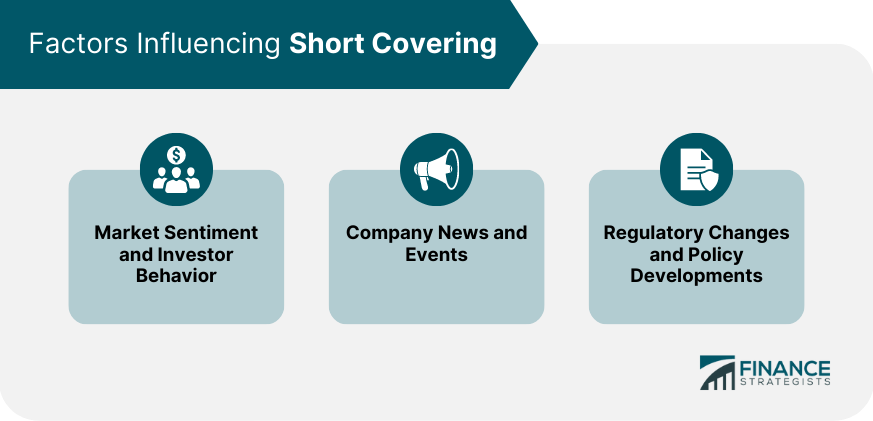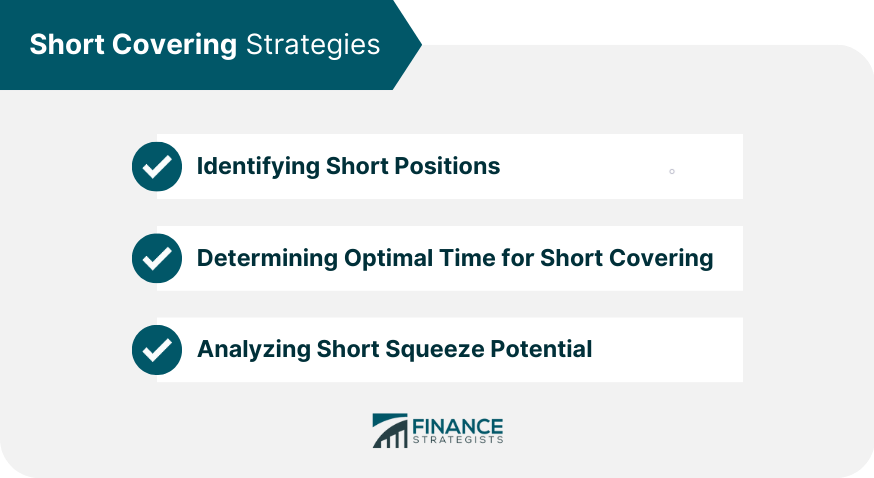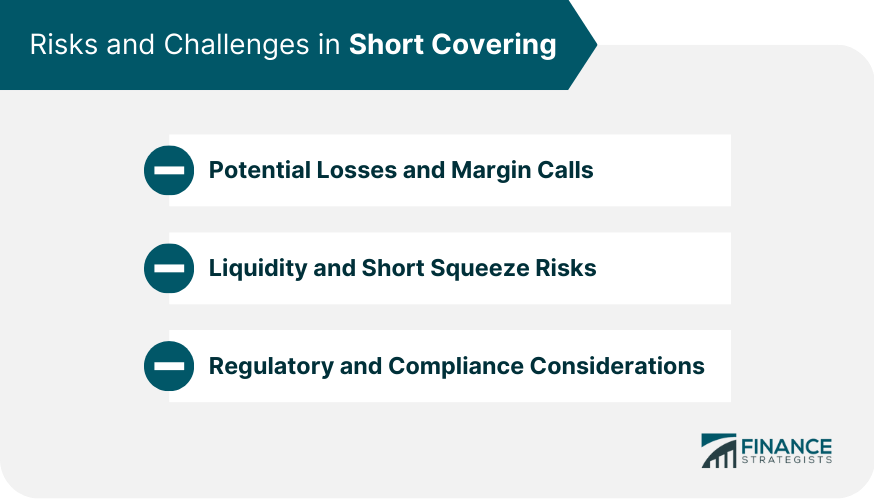Short covering is a term used in financial markets to describe the process of closing out a short position. Short covering occurs when investors buy back the shares they previously borrowed and sold, effectively closing out their short positions. Short covering plays a significant role in wealth management as it affects market dynamics and investor behavior. Understanding the concept of short covering is essential for investors and financial professionals to make informed decisions and manage risks effectively. Short covering is crucial in wealth management as it provides insights into market sentiment and can influence the overall performance of investment portfolios. Short sellers often have a contrarian view on the market, betting against the prevailing sentiment. When short sellers cover their positions by buying back shares, it can signal a change in market sentiment and potentially impact stock prices. Additionally, short covering can contribute to market stability by reducing the number of outstanding short positions. In times of market volatility or uncertainty, short covering can help mitigate downward pressure on stock prices, preventing further market decline. Wealth managers and investors closely monitor short covering activity to gauge market sentiment and adjust their investment strategies accordingly. Short covering plays a crucial role in portfolio management, particularly for investors who engage in short selling or have exposure to short positions. Monitoring short covering activity helps investors assess the prevailing market sentiment and understand the dynamics of supply and demand for a particular stock. By analyzing short covering trends, portfolio managers can make informed decisions regarding their short positions. Short covering can indicate potential upward pressure on stock prices, prompting portfolio managers to adjust their positions to minimize losses or lock in profits. It allows investors to actively manage their portfolios, taking advantage of market movements and adjusting their positions based on changing market conditions. Furthermore, short covering can also influence portfolio diversification strategies. Understanding short interest in various stocks or sectors can help investors identify potential risks and opportunities. By actively monitoring short covering activities, portfolio managers can make informed decisions about portfolio rebalancing and ensure that their portfolios are well-positioned to navigate market fluctuations. Market sentiment and investor behavior are significant factors influencing short covering. When overall market sentiment turns positive or becomes more bullish, short sellers may feel pressured to cover their positions to limit potential losses. Positive market sentiment can be driven by factors such as favorable economic indicators, positive earnings reports, or optimistic market outlooks. As short sellers buy back shares, it creates additional demand, potentially driving stock prices higher. Conversely, if market sentiment turns negative or becomes more bearish, short covering activity may decrease as short sellers maintain or increase their positions. Negative market sentiment can be influenced by factors such as economic downturns, geopolitical tensions, or adverse news events. Monitoring market sentiment is crucial for investors to anticipate short covering activity and its potential impact on stock prices. Company-specific news and events can significantly influence short covering activity. Positive news such as strong earnings reports, successful product launches, or strategic partnerships can trigger short covering as short sellers reassess their positions. Positive developments can create upward momentum in stock prices, leading short sellers to cover their positions to avoid further losses. Conversely, negative news such as disappointing earnings, regulatory investigations, or product recalls can drive short sellers to maintain or increase their positions, anticipating further declines in stock prices. Company news and events are closely watched by investors to assess the potential impact on short covering and overall market dynamics. Regulatory changes and policy developments can have a profound impact on short covering. New regulations or policy shifts that affect short selling activities or impose restrictions can influence short sellers' behavior. For example, the implementation of stricter regulations or disclosure requirements may lead short sellers to cover their positions to comply with new rules. Similarly, policy developments or government interventions that impact specific industries or companies can also influence short covering. Policy announcements, such as regulatory approvals or policy reforms, can trigger short covering as investors reassess the outlook for affected stocks. Monitoring regulatory changes and policy developments is crucial for investors to understand the potential implications for short covering and adjust their investment strategies accordingly. Identifying short positions is an essential step in implementing short covering strategies. Investors can monitor short interest data, which provides information on the number of shares currently sold short in a particular stock. By analyzing short interest, investors can identify stocks with significant short positions and potential short covering opportunities. Additionally, investors can also analyze short interest ratios, which compare the number of shares sold short to the average daily trading volume. Higher short interest ratios indicate higher levels of short interest relative to the trading volume, potentially indicating a greater likelihood of short covering. Determining the optimal time for short covering involves assessing market conditions, company-specific factors, and potential catalysts. Investors may consider technical analysis indicators, such as trend reversals or price patterns, to identify potential inflection points for short covering. Fundamental analysis, including company earnings, industry outlook, and macroeconomic factors, can also provide insights into the optimal timing for short covering. By evaluating various factors, investors can make informed decisions on when to cover their short positions to maximize potential profits or minimize losses. Short squeezes occur when a significant number of short sellers rush to cover their positions simultaneously, leading to a rapid increase in stock prices. Analyzing short squeeze potential involves monitoring short interest, stock borrow fees, and market dynamics. High short interest combined with increasing stock prices and rising stock borrow fees can indicate the potential for a short squeeze. Investors can analyze these factors to assess the likelihood of a short squeeze and adjust their short covering strategies accordingly. Understanding the dynamics of short squeezes and analyzing the potential for short squeezes is crucial for investors engaging in short selling or considering short covering strategies. Short covering comes with its own set of risks and challenges. One of the primary risks is the potential for losses if stock prices increase significantly. When short sellers cover their positions by buying back shares, they may incur losses if the repurchase price is higher than the initial selling price. Depending on the magnitude of the price increase, the losses can be substantial. Additionally, short sellers must also manage the risk of margin calls. Margin calls occur when the value of the short position exceeds the margin requirement set by the broker. In such cases, the short seller is required to deposit additional funds or securities to meet the margin requirements. Failure to meet margin calls can result in forced liquidation of the short position, potentially locking in losses. Short covering activities can contribute to liquidity risks, especially during periods of high short covering volume. When a significant number of short sellers rush to cover their positions, it can strain market liquidity and potentially lead to price volatility. The increased demand for shares can lead to rapid price increases, creating challenges for short sellers to find available shares to cover their positions. Furthermore, short covering can also be influenced by short squeeze risks. Short squeezes occur when short sellers face difficulties in covering their positions due to limited availability of shares or high borrowing costs. This situation can result in a rapid surge in stock prices, forcing short sellers to cover their positions at even higher prices, exacerbating potential losses. Short selling and short covering activities are subject to regulatory and compliance considerations. Investors engaging in short selling must adhere to applicable regulations and disclose their short positions as required by regulatory authorities. Failure to comply with these regulations can lead to legal consequences and reputational damage. Furthermore, regulatory changes or policy developments can impact short selling activities and introduce new compliance requirements. Investors must stay updated on regulatory developments and ensure they comply with all applicable rules and regulations. Short covering refers to the process of closing out a short position in a financial instrument. It involves buying back the same quantity of the asset that was previously borrowed and sold short, effectively "covering" or reversing the short position. Short covering occurs when traders or investors who have taken a short position in a security decide to buy it back to exit the trade or to mitigate potential losses. Short covering strategies involve identifying short positions, determining the optimal time for short covering, and analyzing short squeeze potential. However, short covering also comes with risks and challenges, including potential losses, liquidity risks, and compliance considerations. Monitoring short covering activity and staying informed about market conditions are essential for successful wealth management.What Is Short Covering?
Role of Short Covering in Portfolio Management
Factors Influencing Short Covering
Market Sentiment and Investor Behavior
Company News and Events
Regulatory Changes and Policy Developments

Short Covering Strategies
Identifying Short Positions
Determining Optimal Time for Short Covering
Analyzing Short Squeeze Potential

Risks and Challenges in Short Covering
Potential Losses and Margin Calls
Liquidity and Short Squeeze Risks
Regulatory and Compliance Considerations

Bottom Line
Short Covering FAQs
Short covering is the process of closing out a short position by buying back the shares that were previously borrowed and sold, effectively reversing the short sale.
Short covering impacts market sentiment, stock prices, and portfolio management. It provides insights into market dynamics, helps manage risk, and allows investors to adjust their portfolios based on changing market conditions.
Market sentiment, investor behavior, company news and events, and regulatory changes are factors that influence short covering activity.
Short covering strategies involve identifying short positions, determining the optimal time for covering, and analyzing short squeeze potential.
Risks in short covering include potential losses, margin calls, liquidity risks, and compliance considerations. Investors need to manage these risks effectively to mitigate potential downsides.
True Tamplin is a published author, public speaker, CEO of UpDigital, and founder of Finance Strategists.
True is a Certified Educator in Personal Finance (CEPF®), author of The Handy Financial Ratios Guide, a member of the Society for Advancing Business Editing and Writing, contributes to his financial education site, Finance Strategists, and has spoken to various financial communities such as the CFA Institute, as well as university students like his Alma mater, Biola University, where he received a bachelor of science in business and data analytics.
To learn more about True, visit his personal website or view his author profiles on Amazon, Nasdaq and Forbes.











